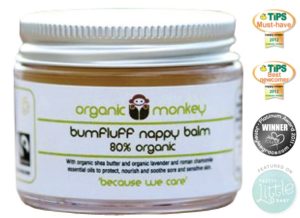What is nappy rash?
Nappy rash affects the skin inside the nappy area, which will appear red, sore and inflamed possibly with small blisters or pimples. It is very common and most babies will experience it at some point. It is caused by the skin being in prolonged contact with wetness inside the nappy, caused by moisture from wee and poo. It seems to be most common in babies aged between eight months and one year, possibly because this is when they are consuming more solid foods which may alter the pH of their urine, making it more acidic.
Uncomfortable as it is, nappy rash is usually easily treated at home and should clear up after a few days. However, if it is left untreated the skin may become infected by bacteria, leading to yellow pimples or oozing patches on the skin and possibly a fever. It could also develop into thrush, a yeast infection which can be common if baby has had a course of antibiotics which kill off the beneficial bacteria which keep naturally-occuring yeasts under control. For this reason it is best to treat nappy rash early on and to act as soon as you see a sore bottom!
How can I treat it?
Keep your baby’s bottom completely clean and dry, and change nappies frequently and certainly as soon as you think they have done a wee or poo. It is advisable to steer clear of baby wipes which often contain alcohol, preservatives and other chemicals which may irritate sore skin. Instead, use plain water and cotton wool to thoroughly clean your baby’s bottom, and pat the skin dry with a clean muslin or cloth. Once baby’s skin is completely dry, apply a thin layer of barrier cream or balm before putting on a clean nappy.
By far the quickest way to speed the healing of nappy rash is to allow your baby to have as much nappy-free time as possible, exposing the skin to the air. After cleaning, but before applying any barrier creams, let your little one kick about on a towel, or walk or crawl around with their skin exposed from the waist down. Obviously, accidents will happen, so this may be easier if you can be in a room without carpet or outside in the garden. Another technique is to loosely tie a large muslin “Tarzan-style” around baby’s hips, which will serve to catch some accidents but will allow the skin to breathe more than being in a nappy.
Nappy rash should begin to clear up and start to heal after three or four days. If you have not seen any improvement in this time, or you suspect a secondary infection, it would be advisable to see your Health Visitor or GP for advice.
How can I prevent nappy rash?
- Try to give baby some nappy-free time each day.
- Change nappies as frequently as possible, and allow them to fit loosely to allow for some air circulation.
- Clean baby’s skin thoroughly after each nappy change.
- Use a barrier cream at each nappy change to protect baby’s skin from contact with moisture.

Our Bumfluff Organic Nappy Balm was developed to naturally relieve chapped and irritated skin. Using a cleverblend of organic ingredients this balm provides a highly effective, protective barrier, whilst still allowing the skin to breathe, keeping your little monkeys bottom in peachy condition. Made with Fairtrade Shea Butter, Beeswax and organic Lavender and Roman Chamomile essential oils which work to nourish, restore and protect irritated areas whilst increasing the skins natural moisture retention capacity. Our unscented version is particularly suited to sore, sensitive skin. Bumfluff allows the skin to breathe Perfect for a protected, happy bottom!
THE STAR INGREDIENTS
- Organic & Fairtrade Shea Butter – an excellent moisturiser, packed with vitamins A & E and with strong anti-inflammatory properties, Shea is perfect for baby’s skin. It works deep in the skin leaving it soft and smooth and helps to improve skin damage and conditions such as redness and eczema whilst protecting the and keeping skin healthy
- Organic & Fairtrade Olive Oil – Olive oil’s nourishing, softening and protecting properties make it ideal to use on baby’s. It is also an anti-inflammatory and so great to use when treating skin irritations.
- Organic Lavender essential oil – Lavender has antibacterial and healing properties, making it perfect for sensitive skin. It’s also well known for helping alleviate the symptoms of eczema and psoriasis
- Organic Roman Chamomile essential oil – the gentlest form of chamomile, it encourages relaxation, serenity and possesses pain relieving properties – ideal for calming stressed out little monkeys
